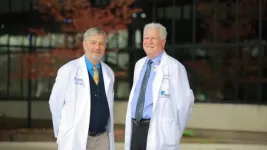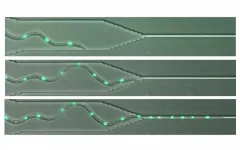Ancient light illuminates matter that fuels galaxy formation
2021-03-16
(Press-News.org) ITHACA, N.Y. - Using light from the Big Bang, an international team led by Cornell University and the U.S. Department of Energy's Lawrence Berkeley National Laboratory has begun to unveil the material which fuels galaxy formation.
"There is uncertainty on the formation of stars within galaxies that theoretical models are unable to predict," said lead author Stefania Amodeo, a Cornell postdoctoral researcher in astronomy in the College of Arts and Sciences, who now conducts research at the Observatory of Strasbourg, France. "With this work, we are providing tests for galaxy formation models to comprehend galaxy and star formation."
The research, "Atacama Cosmology Telescope: Modeling the Gas Thermodynamics in BOSS CMASS galaxies from Kinematic and Thermal Sunyaev-Zel'dovich Measurements," appears in the March 15 edition of Physical Review D.
Proto galaxies are always full of gas and when they cool, the galaxies start to form, said senior author Nick Battaglia, assistant professor of astronomy at Cornell. "If we were to just do a back-of-the-envelope calculation, gas should turn into stars," he said. "But it doesn't."
Galaxies are inefficient when they manufacture stars, Battaglia said. "About 10% of the gas - at most - in any given galaxy gets turned into stars," he explained, "and we want to know why."
The scientists can now check their longtime theoretical work and simulations, by looking at microwave observations with data and applying a 1970s-era mathematical equation. They've looked at data from Atacama Cosmology Telescope (ACT) - which observes the Big Bang's static-filled cosmic microwave background (CMB) radiation - and search for the Sunyaev-Zel'dovich effects. That combination of data enables the scientists to map out the material around that indicate the formation of galaxies in various stages.
"How do galaxies form and evolve in our universe?" Battaglia said. "Given the nature of astronomy, we can't sit and watch a galaxy evolve. We use various telescopic snapshots of galaxies - and each has its own evolution - and we try and stitch that information together. From there, we can extrapolate Milky Way formation."
Effectively, the scientists are using the cosmic microwave background - remnants of the Big Bang - as a backlit screen that is 14 billion years old to find this material around galaxies.
"It's like a watermark on a bank note," said co-author Emmanuel Schaan, the Chamberlain postdoctoral fellow at the Lawrence Berkeley National Laboratory. "If you put it in front of a backlight then the watermark appears as a shadow. For us, the backlight is the cosmic microwave background. It serves to illuminate the gas from behind, so we can see the shadow as the CMB light travels through that gas."
Together with Simone Ferraro, divisional fellow at Lawrence Berkeley, Schaan led the measurement part of the project.
"We're making these measurements of this galactic material at distances from galaxy centers never before done," Battaglia said. "These new observations are pushing the field."
INFORMATION:
In addition to Battaglia, Amodeo, Cornell researchers include doctoral students Emily Moser, Victoria Calafut, Eve Vavagiakis; Steve K. Choi, National Science Foundation postdoctoral fellow at the Cornell Center for Astrophysics and Planetary Astronomy; Rachel Bean, professor of astronomy and senior associate dean in the College of Arts and Sciences; and Mike Niemack, associate professor of physics and astronomy in the College of Arts and Sciences.
The ACT team is an international collaboration, with scientists from 41 institutions in seven countries.
In addition to the National Science Foundation's Atacama Cosmology Telescope, the work was supported by the Baryon Oscillation Spectroscopic Survey in New Mexico, where the Berkeley Lab played a leading role; the European Space Agency's Planck telescope and the Herschel Space Telescope; and the Cori supercomputer at Berkeley Lab's National Energy Research Scientific Computing Center.
A National Science Foundation Astronomy and Astrophysics research grant funded the research.
ELSE PRESS RELEASES FROM THIS DATE:
2021-03-16
CHAMPAIGN, Ill. -- Agricultural scientists who study climate change often focus on how increasing atmospheric carbon dioxide levels will affect crop yields. But rising temperatures are likely to complicate the picture, researchers report in a new review of the topic.
Published in the Journal of Experimental Botany, the review explores how higher temperatures influence plant growth and viability despite the greater availability of atmospheric CO2, a key component of photosynthesis.
Excessive heat can reduce the efficiency of enzymes that drive photosynthesis and can hinder plants' ability to regulate CO2 uptake and water loss, the researchers write. Structural features can make plants more - or less - susceptible to heat stress. Ecosystem attributes - such as the size ...
2021-03-16
The symptoms of postural orthostatic tachycardia syndrome, or POTS, can be as varied as they are confounding.
There can be fatigue, pain, bleeding disorders and anxiety. Heart palpitations and lightheadedness are common. Some patients experience gastrointestinal issues or brain fog. For the most severely affected, the simple act of standing up can send them crumpling into unconsciousness.
Though likely much more common than once thought, POTS remains something of a mystery. Many physicians have never heard of it. There's no lab test to confirm a diagnosis and no treatment to cure the condition.
That could all be ...
2021-03-16
The hummingbird is named after its pleasant humming sound when it hovers in front of flowers to feed. But only now has it become clear how the wing generates the hummingbird's namesake sound when it is beating rapidly at 40 beats per second. Researchers from Eindhoven University of Technology, Sorama, a TU/e spin-off company, and Stanford University meticulously observed hummingbirds using 12 high-speed cameras, 6 pressure plates and 2176 microphones. They discovered that the soft and complex feathered wings of hummingbirds generate sound in a fashion ...
2021-03-16
Tsukuba, Japan - Fungi are a vital part of nature's recycling system of decay and decomposition. Filamentous fungi spread over and penetrate surfaces by extending fine threads known as hyphae.
Fungi that cause disease within living organisms can penetrate the spaces between tightly connected plant or animal cells, but how their hyphae do this, and why the hyphae of other fungal species do not, has been unclear.
Now, a team led by Professor Norio Takeshita at University of Tsukuba, with collaborators at Nagoya University and in Mexico, has discovered a key feature that helps explain the differences among species. They compared seven fungi from different taxonomic groups, including some ...
2021-03-16
Washington, D.C. - March 16, 2021 - For the first time, researchers have isolated the fungus Candida auris from a sandy beach and tidal swamp in a remote coastal wetland ecosystem. The discovery, reported this week in mBio, an open-access journal of the American Society for Microbiology, represents the first evidence that the pathogen thrives in a natural environment and is not limited to mammalian hosts. C. auris can cause infections resistant to major antifungal drugs, and since its identification in clinical patients 10 years ago scientists have sought to understand its origins.
A ...
2021-03-16
SLOW walkers are almost four times more likely to die from COVID-19, and have over twice the risk of contracting a severe version of the virus, according to a team of researchers from the National Institute for Health Research (NIHR) Leicester Biomedical Research Centre led by Professor Tom Yates at the University of Leicester.
The study of 412,596 middle-aged UK Biobank participants examined the relative association of body mass index (BMI) and self-reported walking pace with the risk of contracting severe COVID-19 and COVID-19 mortality.
The analysis found slow walkers of a normal weight to be almost 2.5 times more likely to develop severe COVID-19 and 3.75 times more likely to die from the virus ...
2021-03-16
Boston, Mass. - Just one year after the World Health Organization declared the novel coronavirus a global pandemic, three COVID-19 vaccines are available in the United States, and more than 2 million Americans are receiving shots each day. Americans are eager to get back to business as usual, but experts caution that opening the economy prematurely could allow a potential resurgence of the virus. How foot traffic patterns in restaurants and bars, schools and universities, nail salons and barbershops affect the risk of transmission has been largely unknown.
In an article published ...
2021-03-16
LA JOLLA, CALIF. - March 16, 2021 - A Nature study authored by scientists at Sanford Burnham Prebys Medical Discovery Institute and the University of Hong Kong shows that the leprosy drug clofazimine, which is FDA approved and on the World Health Organization's List of Essential Medicines, exhibits potent antiviral activities against SARS-CoV-2 and prevents the exaggerated inflammatory response associated with severe COVID-19. Based on these findings, a Phase 2 study evaluating clofazimine as an at-home treatment for COVID-19 could begin immediately.
"Clofazimine is an ideal candidate for a COVID-19 treatment. It is safe, affordable, easy to make, taken as a pill and can be made globally available," ...
2021-03-16
A study by Queen Mary University of London researchers, funded by Cancer Research UK, confirms the role of the oestrogen receptor biomarker in ductal carcinoma in situ and presents a new and more accurate method to predict long term outcomes for this pre-invasive stage of breast cancer. The study is published in Clinical Cancer Research.
Oestrogen receptor (ER), a protein expressed in some breast cancer cells, is routinely tested in invasive breast cancer to predict long-term outcomes select treatment options. Its role in ductal carcinoma in situ (DCIS) has been previously unclear, and it is not generally evaluated in this pre-invasive stage of breast cancer. The new research confirms the role of ER in predicting ...
2021-03-16
A new study in Nicotine & Tobacco Research, published by Oxford University Press, finds that the use of high-strength nicotine e-cigarettes can help adults with schizophrenia spectrum disorders quit smoking.
Some 60-90% of people with schizophrenia smoke cigarettes, compared to 15-24% of the general population. The researchers from the University of Catania, in collaboration with colleagues from City University of New York and Weill Medical College of Cornell University, have assessed here the feasibility of using a high-strength nicotine e-cigarette to modify smoking behavior in people with schizophrenia spectrum disorders who smoke cigarettes. In this study ...
LAST 30 PRESS RELEASES:
[Press-News.org] Ancient light illuminates matter that fuels galaxy formation





